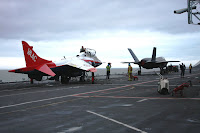December 31, 2008
From the Department of Defense
WASHINGTON (NNS) -- The Navy's newest nuclear-powered aircraft carrier George H.W. Bush will be commissioned Jan. 10, 2009, during a ceremony at Naval Station Norfolk, Va.
President George W. Bush will deliver the principal address. Dorothy "Doro" Bush Koch, daughter of the ship's namesake, is the ship's sponsor. In the time-honored Navy tradition, she will give the order to "man our ship and bring her to life!"
The last Nimitz-class aircraft carrier is named to honor World War II naval aviator and America's 41st president George H. W. Bush. Born on June 12, 1924, in Milton, Mass., Bush began a lifetime of service to America when he joined the Navy on his 18th birthday as a seaman. He became the youngest pilot in the Navy at the time, receiving his commission and naval aviator wings before his 19th birthday.
Bush flew the Avenger torpedo bomber in combat from the carrier USS San Jacinto. During an attack on enemy installations near Chichi Jima in September 1944, his plane was hit by enemy fire while making a bombing run. Although the plane was on fire and heavily damaged, he completed a strafing run on the target before bailing out of the doomed aircraft. Bush parachuted into the sea and was later rescued by the Navy submarine USS Finback. He was later awarded the Distinguished Flying Cross and three Air Medals for his Navy service in the Pacific theater during World War II.
After his time in the Navy ended in September 1945, Bush held a number of public service roles that included two terms as a U.S. congressman from Texas, ambassador to the United Nations, chief of the U.S. Liaison Office to China and director of the Central Intelligence Agency. He then served two terms as vice president under the late President Ronald Reagan before being elected himself as president of the United States in 1988. As commander-in-chief, Bush led the United States and a coalition of nearly 30 other nations during Operation Desert Storm, which ended Iraq's invasion of Kuwait and liberated the people of the Persian Gulf nation.
Capt. Kevin O'Flaherty, from Los Angeles, and a 1981 Naval Academy graduate, will become the ship's first commanding officer, leading a crew of more than 5,500 men and women, including embarked air wing personnel. George H. W. Bush will be initially homeported in Norfolk, Va., assigned to the U.S. Atlantic Fleet.
Construction of the tenth Nimitz-class ship took place at Northrop Grumman-Newport News, Va., starting with the ship's keel laying Sept. 6, 2003, and christening Oct. 7, 2006. George H. W. Bush towers 20 stories above the waterline, displaces approximately 95,000 tons of water, has a flight deck width of 252 feet, and at 1,092 feet long, is nearly as long as the Empire State Building is tall. This floating airfield has a flight deck that covers 4.5 acres. Bush's two nuclear reactors are capable of more than 20 years of continuous service without refueling, providing virtually unlimited range and endurance, and a top speed in excess of 30 knots.
The ship will support a wide variety of aircraft, including the F/A-18C Hornet and F/A-18E/F Super Hornet strike fighters, the E-2C/D Hawkeye Airborne Early Warning aircraft, the C-2 Greyhound logistics aircraft, the EA-6B Prowler and the EA-18G Growler electronic warfare aircraft, multi-role SH-60 and MH-60 helicopters, and other future carrier-based aircraft.
Technorati Tags:
US Navy (USN)
